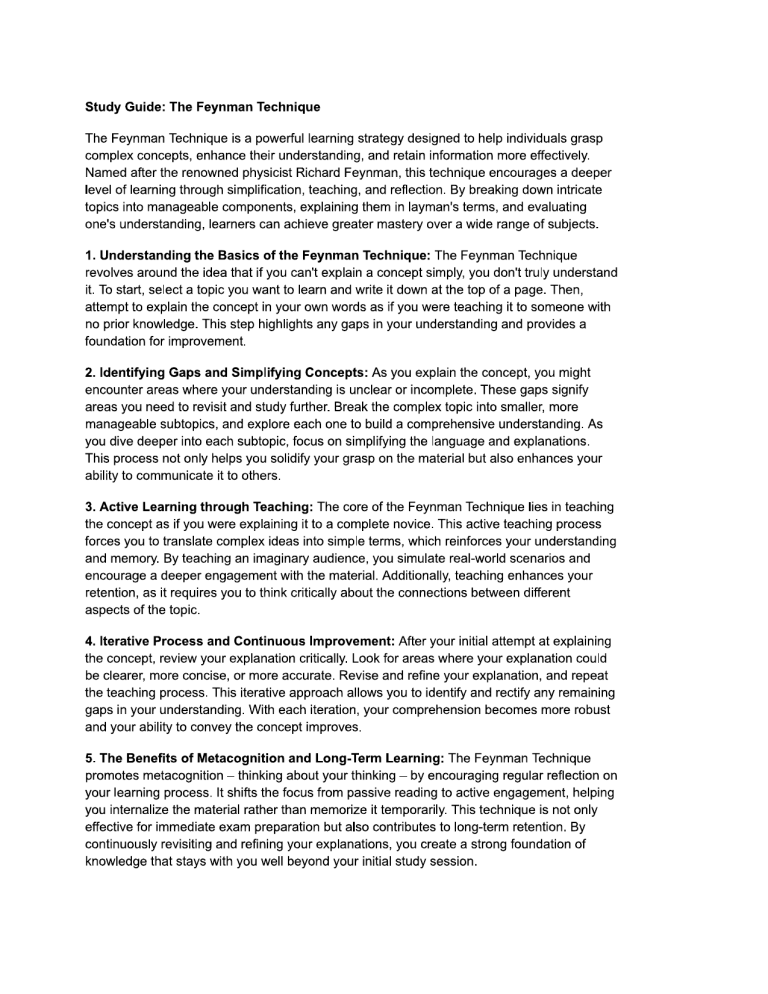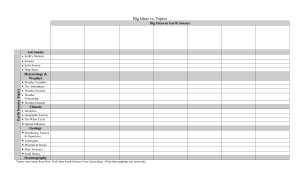
Study Guide: The Feynman Technique The Feynman Technique is a powerful learning strategy designed to help individuals grasp complex concepts, enhance their understanding, and retain information more effectively. Named after the renowned physicist Richard Feynman, this technique encourages a deeper level of learning through simplification, teaching, and reflection. By breaking down intricate topics into manageable components, explaining them in layman's terms, and evaluating one's understanding, learners can achieve greater mastery over a wide range of subjects. 1. Understanding the Basics of the Feynman Technique: The Feynman Technique revolves around the idea that if you can't explain a concept simply, you don't truly understand it. To start, select a topic you want to learn and write it down at the top of a page. Then, attempt to explain the concept in your own words as if you were teaching it to someone with no prior knowledge. This step highlights any gaps in your understanding and provides a foundation for improvement. 2. Identifying Gaps and Simplifying Concepts: As you explain the concept, you might encounter areas where your understanding is unclear or incomplete. These gaps signify areas you need to revisit and study further. Break the complex topic into smaller, more manageable subtopics, and explore each one to build a comprehensive understanding. As you dive deeper into each subtopic, focus on simplifying the language and explanations. This process not only helps you solidify your grasp on the material but also enhances your ability to communicate it to others. 3. Active Learning through Teaching: The core of the Feynman Technique lies in teaching the concept as if you were explaining it to a complete novice. This active teaching process forces you to translate complex ideas into simple terms, which reinforces your understanding and memory. By teaching an imaginary audience, you simulate real-world scenarios and encourage a deeper engagement with the material. Additionally, teaching enhances your retention, as it requires you to think critically about the connections between different aspects of the topic. 4. Iterative Process and Continuous Improvement: After your initial attempt at explaining the concept, review your explanation critically. Look for areas where your explanation could be clearer, more concise, or more accurate. Revise and refine your explanation, and repeat the teaching process. This iterative approach allows you to identify and rectify any remaining gaps in your understanding. With each iteration, your comprehension becomes more robust and your ability to convey the concept improves. 5. The Benefits of Metacognition and Long-Term Learning: The Feynman Technique promotes metacognition — thinking about your thinking — by encouraging regular reflection on your learning process. It shifts the focus from passive reading to active engagement, helping you internalize the material rather than memorize it temporarily. This technique is not only effective for immediate exam preparation but also contributes to long-term retention. By continuously revisiting and refining your explanations, you create a strong foundation of knowledge that stays with you well beyond your initial study session. In conclusion, the Feynman Technique is a valuable tool for enhancing understanding and learning efficiency. By breaking down complex concepts, simplifying explanations, actively teaching, and embracing a reflective approach, learners can master even the most intricate subjects. Through its emphasis on active engagement and continuous improvement, the Feynman Technique empowers students to become effective learners who can grasp and communicate complex ideas with confidence.


